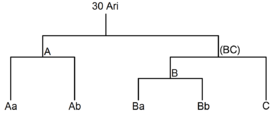30 Arietis
Coordinates:  02h 36m 00.5237s, +24° 38′ 50.000″
02h 36m 00.5237s, +24° 38′ 50.000″
| Observation data Epoch J2000 Equinox J2000 | ||
|---|---|---|
| Constellation | Aries | |
| 30 Arietis A | ||
| Right ascension | 02h 37m 00.5235s[1] | |
| Declination | +24° 38′ 49.9880″[1] | |
| 30 Arietis B | ||
| Right ascension | 02h 36m 57.7449s[2] | |
| Declination | +24° 38′ 53.0026″[2] | |
| Characteristics | ||
| Spectral type | F5 V / F6 V[3] | |
| B−V color index | 0.410 / 0.510[3] | |
Semi-major axis (a) 40" | (1670 AU) | |
Semi-major axis (a) 22.3 AU | | |
Inclination (i) 4.14+0.96 | −0.90°[6]° | |
| Details | ||
| 30 Arietis A | ||
Myr | ||
| Details | ||
| 30 Arietis Bb | ||
| Mass | 147+41 −29[6] MJup | |
| Other designations | ||
| Database references | ||
Exoplanet Archive | data | |
| Data sources: | ||
30 Arietis (abbreviated 30 Ari) is a 6th-
light years away. The main components of both systems are both binaries with a composite spectra belonging to F-type main-sequence stars, meaning they are fusing hydrogen in their cores. The 30 Arietis system is 910 million years old, one fifth the age of the Sun
.
Star system
30 Arietis A and B are separated by 38.1", corresponding to 1,500
light years. The pair are at almost the same distance, have very similar proper motions, and are considered almost certain to be gravitationally bound with a likely period around 34,000 years.[5] The main components of both systems are both binaries with a composite spectra belonging to F-type main-sequence stars, meaning they are fusing hydrogen in their cores.[3]
30 Arietis A is a
spectroscopic binary with an orbital period of 1.1 days.[7]
The primary Aa is an F-type main sequence star about 31% more massive than the Sun, while the companion Ab is a faint red dwarf only about 15% the mass of the Sun.
30 Arietis B has been reported to have a red dwarf companion at a distance of 22 AUadaptive optics.[5]
30 Arietis Bb
30 Arietis Bb (sometimes abbreviated 30 Ari Bb) is a
echelle spectrograph installed on the Alfred-Jensch telescope in Karl Schwarzschild Observatory.[3] The star had a minimum mass of nearly 10 times that of Jupiter.[8] In 2020, after the inclination of the planetary orbit was measured to be just 4.14+0.96
−0.90°, the "planet" was found to fall in the mass range of red dwarf stars.[6]
−0.90°, the "planet" was found to fall in the mass range of red dwarf stars.[6]
See also
References
- ^ .
- ^ .
- ^ S2CID 55685116.
- ^ a b Whitney Clavin (2015). "Planet 'Reared' by Four Parent Stars". NASA. Retrieved 4 March 2015.
- ^ S2CID 30908636.
- ^ S2CID 221995447.
- JSTOR 40675565.
- ^ Jean Schneider (2011). "Notes for Planet 30 Ari B b". Extrasolar Planets Encyclopaedia. Retrieved 3 October 2011.
External links

